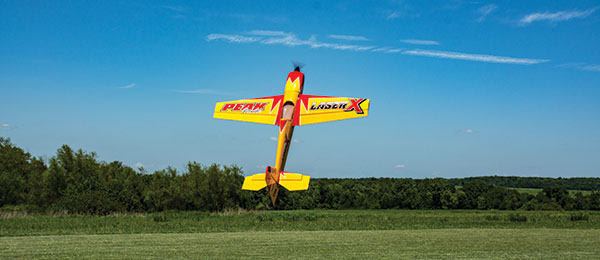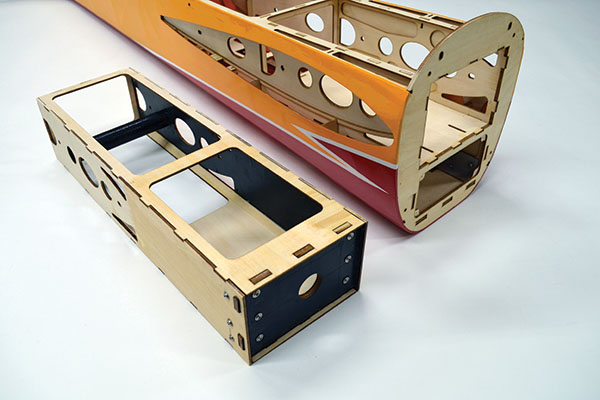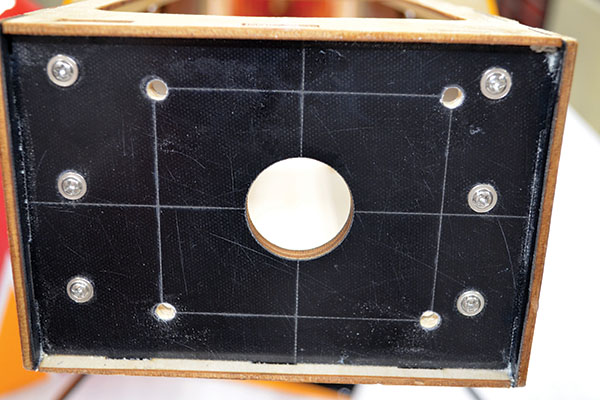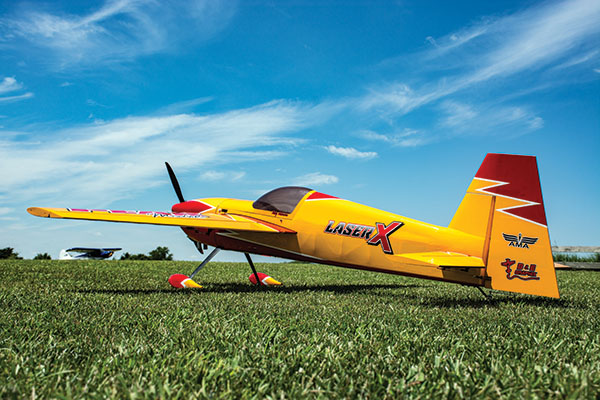Peak Model Acro 31% LaserX 55-60cc EP/GP ARF

Written by Troy Hamm A 3-D-ready thoroughbred Product review As seen in the January 2018 issue of Model Aviation.
Bonus Video
Specifications
Model type: Mid-wing aerobatic aircraft Wingspan: 90 inches Length: 86.6 inches Weight: 16.53 to 17.85 pounds Power system: 50-70cc gasoline engine Radio: Six-channel minimum Servos: Five high-torque metal gear; one metal gear throttle servo Price: $599Test-Model Details
Power system: DLE-55 engine Wingspan: 90 inches Length: 86 inches Wing area: 1,472 square inches Radio system: Futaba 14SG transmitter; two Futaba R6008HS eight-channel receivers; five MKS HV777 servos; one JR 8411 servo Propeller: 23 x 8 Acro carbon-fiber two-blade Receiver Two Wrong Way RC Battery: 2,300 mAh 2S A123 Ready-to-fly weight: 17 pounds, 10 ounces Flight duration: 8 minutesPluses
• Flies precision aerobatics and 3-D well. • Nice-looking color scheme. • Many carbon-fiber components. • High-quality fuel tank included. • Adhesive included.Minus
• No construction manual or CD enclosed. • No wing or stabilizer bags included.Product Review
Peak Model manufactures ARF gasoline-powered airplanes in sizes ranging from 30cc to 70cc. Some of the aircraft that Peak Model has available include the Extra 330sc, MXS-R, Sbach 342, Corvus 540, Slick 580, and the new LaserX. The company also sells engines, propellers, and the electronics needed to outfit its aircraft. I ordered the LaserX, DLE-55 engine, and an Acro 23 x 8 carbon-fiber propeller to power my LaserX. The Laser design was developed by Leo Loudenslager, the full-scale 1980 World Aerobatic Champion. Leo’s Laser started life as a Stephens Akro. He completed construction of the Akro in 1970 and modified the aircraft during a five-year timespan. In 1975, he renamed it the Laser 200. Leo won multiple national championships and performed in many air shows with the Laser. The Laser 200 is a highly aerobatic single-seat aircraft powered by a 200 hp Lycoming engine. Peak Model recently released its version of the Laser 200 called the LaserX. The LaserX features oversize control surfaces optimized for today’s extreme 3-D maneuvers. The LaserX is designed to be powered by a 50cc to 70cc gasoline engine and is constructed with balsa and light plywood. Carbon-fiber reinforcement throughout the airframe makes the structure more rigid and adds strength. The LaserX features a plug-in two-piece wing and horizontal stabilizers. The airplane is covered with high-quality Oracover plastic covering and features a fiberglass cowling and wheel pants. Included with the kit are a wing tube, stabilizer tube, landing gear, tail wheel assembly, and spinner—all made from carbon fiber.Assembly
The kit arrived in a large, heavy-duty box. The airplane was well protected and damage free. An interesting and innovative feature of the LaserX is its removable motor box. Peak Model packages the airplane without the motor box installed in the fuselage. This allows the airplane to be shipped in a smaller box, decreasing the shipping cost.
The motor box is not installed at the factory. Two-part epoxy is included to secure the motor box.
The airplane comes with an ample supply of 90-minute epoxy to secure the motor box and control surfaces. The kit does not include a construction manual. A generic manual that covers all of the Peak Model aircraft is available on the company’s website. The first assembly step is installing the motor box into the fuselage. I applied the 90-minute epoxy to the outside of the motor box and then slid it into the fuselage. The motor box fit perfectly in place. The next step is attaching the control surfaces. The 90-minute epoxy provided plenty of time to ensure that the control surfaces were positioned correctly and wouldn’t bind through their deflections. The supplied epoxy was also used to secure the carbon-fiber control horns. After the servos are installed in the airframe, they are connected to the control surfaces by adjustable pushrods. The pushrods feature normal threads on one end and reverse threads on the other. This allows for quick pushrod length adjustments. The rudder utilizes pull-pull cables that cross inside of the fuselage. When the cables are attached to the rudder servo, the rudder installation is complete. The carbon-fiber main gear and tail wheel bracket were installed next. They fit perfectly and were secured with socket head cap screws. I installed the wheels and wheel pants at the end of the build. The firewall is premarked for the DLE-55 bolt pattern. After the holes were drilled in the firewall, the engine was installed with the mounting hardware that was included with the engine. The throttle servo was mounted inside of the fuselage and connected to the carburetor with the included pushrod and ball links. A choke linkage was fashioned out of a piece of scrap aluminum and a piece of 4-40 pushrod material. The ignition unit was mounted inside of the motor box.

The carbon-fiber-reinforced firewall comes premarked for the DLE mounting pattern.
Also mounted inside of the motor box is a Tech Aero Ultra IBEC (Ignition Battery Eliminator Circuit), which is used to power the ignition unit. The IBEC’s LED power indicator light was mounted on the outside of the fuselage. Included with the airplane was a high-quality clear fuel tank. Tygon fuel line was used to connect the fuel tank to the engine. I purchased a fuel dot at a local hobby shop and mounted it on the side of the fuselage.

The spacious fuselage provides plenty of room for the fuel system and radio equipment.
Two A123 battery packs and two Futaba R6008HS FAAST receivers were mounted inside of the fuselage. A rotary tool with a sanding drum was used to open the bottom of the cowling for cylinder head clearance and cooling. The large cowling easily fit over the engine and the Slimline wraparound Pitts muffler. The included carbon-fiber spinner and a Peak Model Acro 23 x 8 carbon-fiber propeller completed the powerplant installation. Peak Model recommends 20° of control surface deflection for low-rate settings on the ailerons and the elevator. The high-rate aileron and elevator recommendation is 40° of deflection. The rudder deflection on low rate is 30° and the high-rate setting is 45°. The manual recommends 25% to 30% exponential on low rates, and 45% on high rates. Remember to use a negative exponential number for Futaba transmitters. Most other brands of transmitters use a positive number. The airplane balanced at 8 inches back from the leading edge of the wing when measured at the fuselage. The LaserX weighed 17 pounds, 10 ounces, ready to fly without fuel.
Flight Report
At the flying field, the LaserX was assembled and given a thorough preflight inspection. A range check was performed with and without the engine running. After pictures were taken, it was time for the LaserX’s first flight. The LaserX tracked straight on takeoff with little rudder input needed. The DLE-55 provided plenty of power and the airplane was airborne in less than 100 feet. For straight-and-level flight, the LaserX required two clicks of up-elevator trim and one click of right rudder trim. The center of gravity was nearly perfect and required merely a slight amount of forward stick for level, inverted flight. The LaserX is a solid-flying model, which makes it excel at flying International Miniature Aerobatic Club-style precision maneuvers. It handles windy conditions well and is stable at slow speed, which helps make it easy to land. The control surfaces are large and effective. On the high-rate aileron setting, it will perform fast aileron rolls, while the low-rate settings provide for a more docile aircraft. The LaserX has a tall fuselage, and because of that it requires little rudder input to maintain knife-edge flight. With the Side Force Generators installed, the LaserX required less rudder input to maintain straight-and-level knife-edge flight. The airplane is stable during high-alpha 3-D maneuvers and never showed a tendency to snap roll or tip stall when slowed. When the LaserX stalls, the nose falls straight ahead and recovers quickly by adding a little power.Conclusion
Overall, I am happy with the Peak Model Acro 31% LaserX 55-60cc EP/GP ARF. It’s a nice-looking and great-flying airplane. I found it to be equally at home flying precision or 3-D maneuvers, and it’s stable throughout its entire speed range. The airplane was easy to build and features a lot of high-quality, carbon-fiber components. The LaserX looks great both in the air and on the ground. Peak Model included a nice set of Breitling Graphics with the kit. I wanted to personalize my LaserX, so I ordered a set of vinyl graphics from B & E Graphix. B & E’s graphic packages are cut from high-quality, air-release vinyl that is easy to install and durable. The graphics package really sets off the red and yellow LaserX’s base color scheme.
The Peak Model Acro 31% LaserX 55-60cc EP/GP ARF has an attractive color scheme that really pops.
—Troy Hamm [email protected]










Add new comment